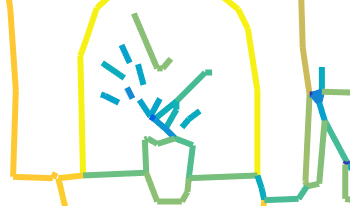
Individuals with aphantasia report either absent or dramatically reduced mental imagery compared to control participants. The image of an object or scene produced “in the mind’s eye” lacks detail for these individuals or is simply not there. Line drawings made from memory are a straightforward way to assess the contents of visual imagery for aphantasic individuals relative to controls. Prior analyses of the Aphantasia Drawing Database have revealed specific impairments in visual memory for objects, but relatively spared scene accuracy, suggesting that the encoding of visual scenes in aphantasia is more complex than an overall reduction in imagery might suggest. Here, we examined the mid-level image statistics of line drawings from this database to determine how simpler visual feature distributions differed as a function of aphantasia and reliance on image recall rather than direct observation during image reproduction. We find clear differences across several different sets of mid-level properties as a function of aphantasia, which offers further characterization of the nature of visual encoding in this condition.